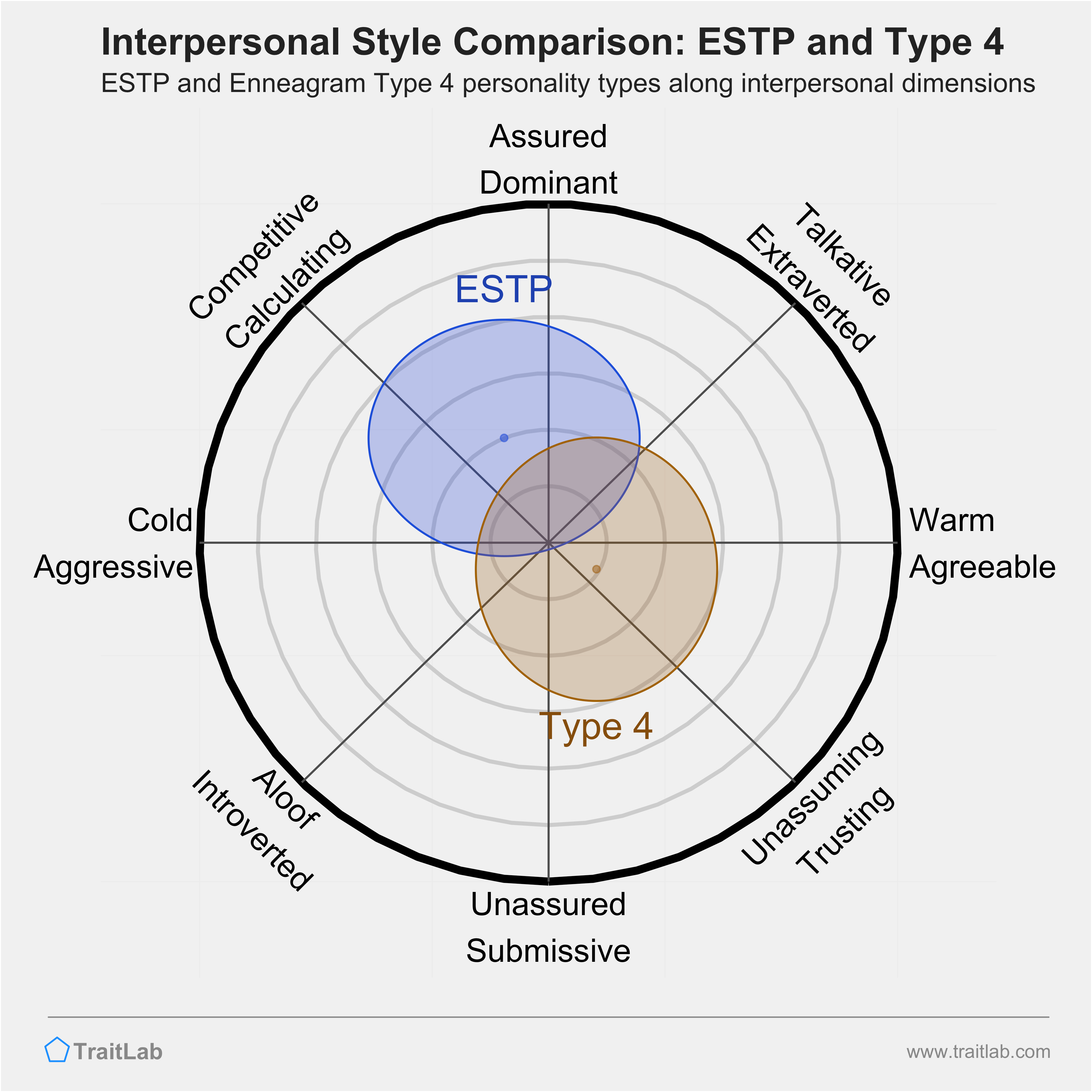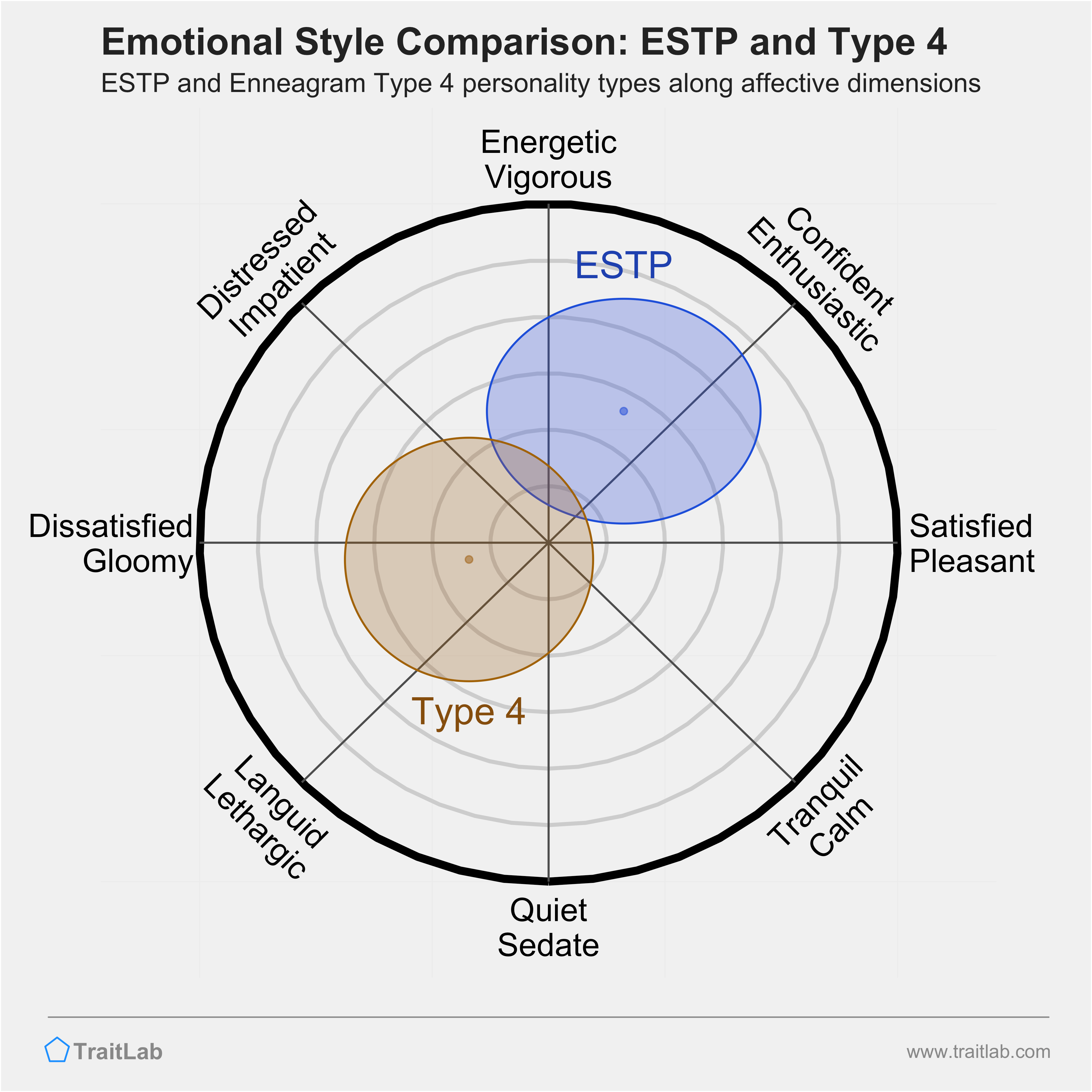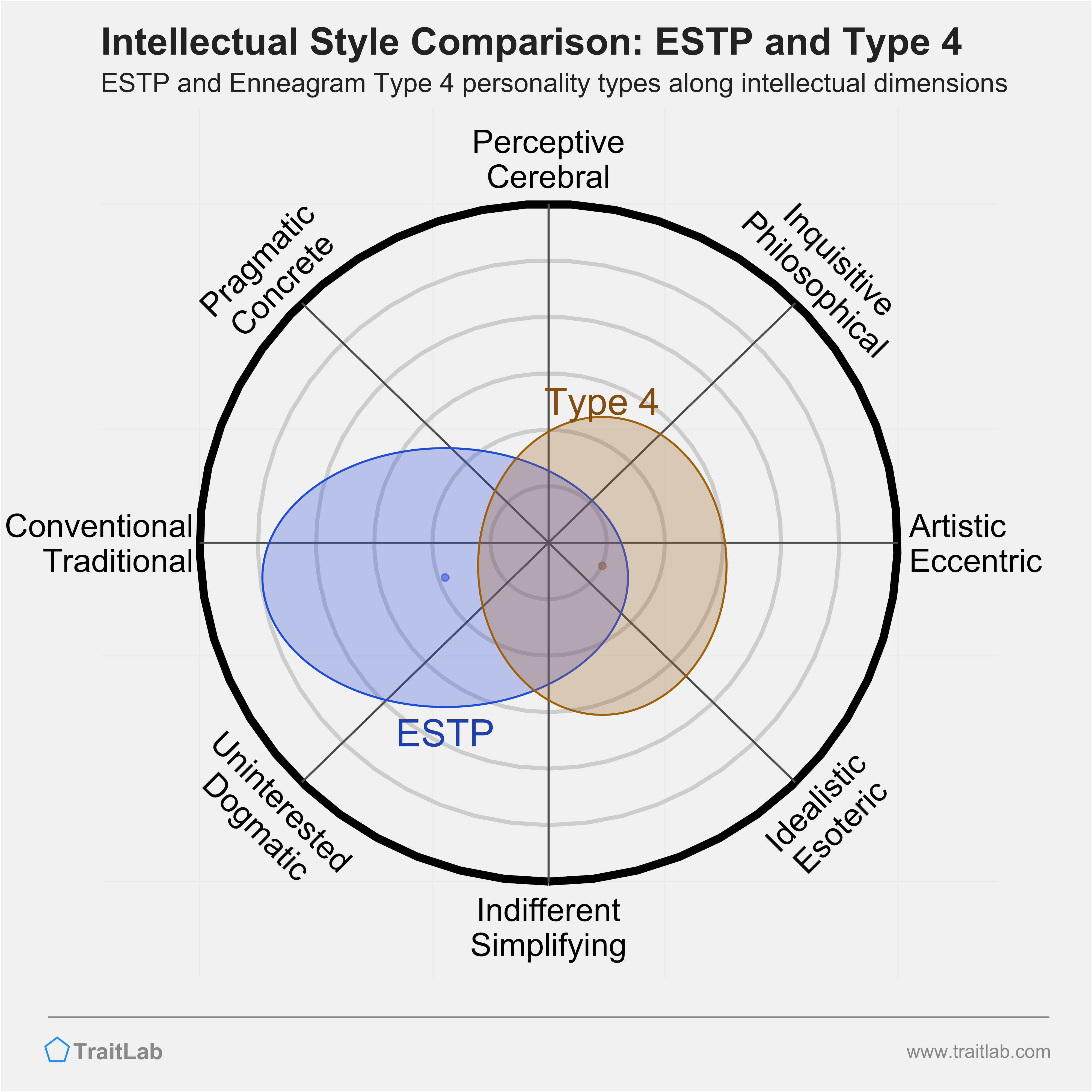How compatible are the ESTP and Enneagram Type 4 patterns of communicating, feeling, and thinking?
Reading time: 5 minutes

Gregory Park, Ph.D.
Author
In this article, you’ll find comparisons of two personality types — ESTPs and the Enneagram Type 4s — across four important personality domains: Interpersonal/Communication Style, Emotional Style, Intellectual Style, and Organizational Style.
TraitLab collected data about personality traits from thousands of participants who identified as a particular type from the 16 Personality or Enneagram typology.
For each comparison area below, you’ll see show the average similarities and differences between ESTPs and Type 4s. While these comparisons are useful for understanding broad trends across these types, it’s important to remember that all personality types are oversimplifications. For an assessment of your unique personality, you’ll want to use an assessment that goes beyond single personality types.
Jump to any section with the links below.

Do you know your personality type?
Learn about your type and so much more with TraitLab's comprehensive personality assessment.
Your particular style of communicating and interacting with others can be described fairly well by two dimensions: assertiveness and warmth.
Assertiveness describes your tendency to assert yourself, lead, and influence others in social situations, while warmth describes your tendencies to empathize and put others’ needs ahead of your own.
People with the same personality type often share some similarities in assertiveness and warmth. In the graph below, you can see where most ESTPs and most Type 4s fall along both of these dimensions.
First, take a look at where people in each type, on average, fall in this interpersonal space.

ESTPs often manage, direct, and try to lead others. At their best, they provide guidance and leadership, and naturally command respect. ESTPs may be domineering, forceful, or overly direct. At their worst, they can be overbearing and micromanaging.
Type 4s often respect others, conform to expectations, and ask for guidance. At their best, they are loyal and reliable, and encourage others to guide and help. Type 4s may be overly clingy, gullible, and have difficulty expressing anger, even when appropriate. At their worst, they will try to please others too much, put others’ needs ahead of their own, and allow others to take advantage of them.
As a ESTP, one notable difference between you and most Type 4s is in your interpersonal warmth. You are likely on the colder, more combative side of the spectrum. Compared to you and other ESTPs, Type 4s can sometimes feel overly focused on feelings and intentions, rather than the facts of the matter at hand.
Another important difference between you and most Type 4s is in your relative assertiveness and dominance in social situations. Like many ESTPs, you tend to be on the more assertive side and feel comfortable taking charge and making decisions. Often, this pairs well with Type 4s more reserved and passive style, but you’ll want to be careful about being overly domineering, forceful, or direct. Unlike you, Type 4s may need additional time and space to share their thoughts and ideas.
Another characteristic of your personality is your emotional style — your tendencies towards different kinds of moods. There are two dimensions that influence emotional style: arousal and valence.
Arousal describes your relative energy level across different situations. Those with high baseline levels of arousal tend to be generally more alert, active, and engaged, while those with a lower baseline are more reserved, subdued, and inhibited.
Valence describes whether these moods tend to be positive (pleasant) or negative (unpleasant). People with a more positively valenced style are more likely to experience emotions like joy, enthusiasm, satisfaction, and serenity. People with a more negatively valenced style are more likely to experience sadness, frustration, dissatisfaction, and anxiety.
The graph below shows where each type, on average, usually sits in this emotional space.

ESTPs tend to be energetic and enthusiastic across most situations. They take on new challenges with excitement, confidence, and a sense of adventure. ESTPs are usually more optimistic than most people, and they generally feel like they can handle what life throws at them.
Type 4s have a tendency to be quiet and inhibited. Compared to most people, they can easily drift into gloom and melancholy. They see the glass as half-empty and have a more skeptical outlook and a hesitant approach to life. For better or worse, Type 4s tend to notice the negatives in most situations. In stressful times, they are more likely to withdraw quietly and retreat inward, rather than share their frustration with others.
As with most ESTPs, you tend to have a higher baseline energy level than most Type 4s. Between the two of you, you are more likely to seek out engaging activities — perhaps social events, outdoor adventures, or a new class, depending on your interests. However, you may find that most Type 4s do not share your enthusiasm and excitement. In general, you likely crave stimulation more than your Type 4 counterparts, and balancing your different appetites for excitement can be an ongoing challenge.
Another difference between ESTPs and Type 4 is in their typical emotional valence, which describes tendencies towards positive or negative emotions. You and most ESTPs tend to fall on the more positive side. Compared to most Type 4s, you and most ESTPs experience positive emotions such as joy, satisfaction, and happiness more often than most Type 4s. Type 4s have the opposite pattern, and they tend to gravitate towards more negative emotions.
These subtle emotional differences often surface in your reactions to new information. The same news that sparks enthusiasm in you and most ESTPs can induce worry in Type 4s. Compared to ESTPs, most Type 4s may need additional time and space to recover from stress.
Your intellectual style describes how you receive, process, and pursue different kinds of information. Differences in intellectual style are captured well by two dimensions: ideas and aesthetics.
Ideas describes your appetite for new information and your interest in complex, challenging material. People high on the ideas dimension have an appreciation for complexity and technical details. People lower on ideas are less interested in learning for learning’s sake, and they prefer to simplify complex topics down to the essential details.
Aesthetics captures your relative interest and sensitivity to aesthetic information and its emotional impact. People higher on the aesthetics dimension usually have strong artistic interests and a deep appreciation for beauty in many forms. Those lower on aesthetics tend to value practical application over artistic merit and usually adhere to more conventional standards of beauty.
In the graph below, you’ll see where ESTPs and Type 4s, on average, fall in this intellectual space.

ESTPs are practical realists. They focus on building practical skills and essential knowledge and are less likely to spend time learning for learning’s sake. In addition, they usually value conventional, tangible accomplishments over artistic expression and rarely feel compelled to develop a creative outlet.
Type 4s are idealistic, creative dreamers. They tend to be interested in the nuances of emotional and artistic experiences, looking for patterns and meaningful insights. Type 4s are comfortable with ambiguity and abstract concepts, focusing on the big picture rather than technical details. They often practice some form of creative expression and are likely to hold a few unconventional, eccentric beliefs.
As a ESTP, you and most Type 4s are down-to-earth, straightforward thinkers. You’d both prefer to stick to the essentials and focus on practical issues, and you try to avoid overcomplicating matters. When you and your Type 4 counterpart are together, your conversations are more likely to revolve around concrete details, facts, and conventional topics rather than theoretical or philosophical ones.
Another difference between ESTPs and Type 4s is their relative interest in aesthetic, artistic, and emotional experiences. As a ESTP, you tend to be more practical and focused on tangible results, while your Type 4 counterpart is more likely to be drawn into the emotional and artistic aspects of an experience. In addition, ESTPs and Type 4s often differ in their receptivity to unconventional and eccentric ways of thinking. Like many ESTPs, you often lean towards well-worn, conventional approaches and view new alternatives with healthy skepticism. In contrast, Type 4s are quicker to do away with convention and embrace a new approach.
Your organizational style describes your habits around organization and planning. Your organizational style influences how you structure your time and physical space. Differences in organizational style fall along two dimensions: industriousness and orderliness.
Industriousness describes your persistence, need for achievement, and intensity of focus. People higher on industriousness usually organize their behavior around a few important long-term goals. People lower on industriousness are usually more focused on the present and will more easily change their focus when new opportunities appear.
Orderliness describes your need for regularity, order, and structure in your environment. People higher on orderliness prefer tidy, organized physical spaces, detailed schedules, and reliable routines. People lower on orderliness can tolerate more disorganization and prefer a more spontaneous, unstructured approach.
The graph below shows the average position of ESTPs and Type 4s along these dimensions of organizational style.

ESTPs often have big, ambitious goals, and they can be unusually resourceful. Once they’ve set their mind on a goal, they often pursue it with tremendous effort. However, ESTPs often resist highly structured, tedious approaches to achieving their goals. They’d rather avoid creating detailed plans and are more comfortable improvising and moving quickly with the resources they have on hand.
Type 4s thrive in unstructured environments with fewer constraints and more room for improvisation and serendipity. They generally focus on enjoying the present rather than preparing for the future. Type 4s highly value spontaneity and the flexibility to change their mind, and they resist setting hard deadlines or rigid expectations.
As with most ESTPs, you and many Type 4s can clash over your need to set goals and use time efficiently. While you have an easier time getting down to work and staying focused, your Type 4 counterpart may be more easily distracted and unpredictable. Working consistently with a narrow focus often comes naturally to many ESTPs like you, but you may find that Type 4s benefit from additional structure to keep them on track. While you enjoy planning and tend to mind the future, your Type 4 counterpart helps you enjoy the present, injecting some much-needed spontaneity into your schedule.
However, ESTPs and Type 4s share a more intuitive, unstructured approach to most areas of their lives. Both of you take life as it comes, and you avoid overly detailed plans and high levels of organization. Compared to most people, the two of you also have higher tolerances for messiness and disorganization.
Most people have complex personalities, and they don’t fit perfectly into a single personality type.
With TraitLab’s comprehensive analyses of your traits, strengths, and interests, you can see how your personality compares to every type from the Enneagram and 16 Personality typologies. Start building your personality profile by creating a free account today.
For comparisons between ESTPs and other Enneagram types, visit any of the type pairings below:
For comparisons between Type 4s and other types from the 16 Personality typology, visit any of the pairings below: